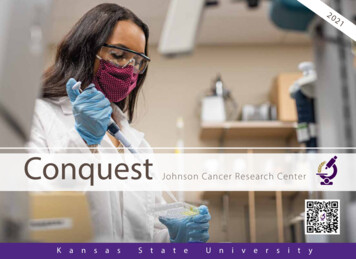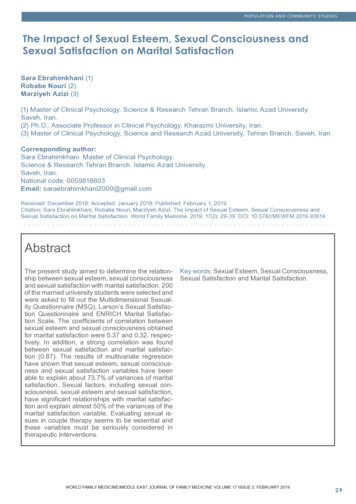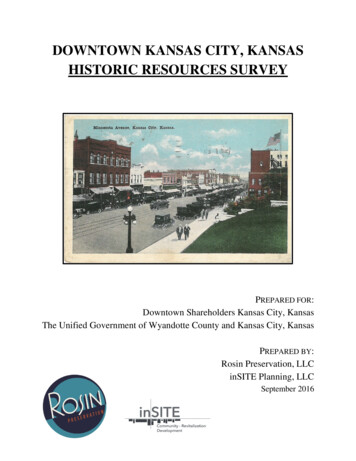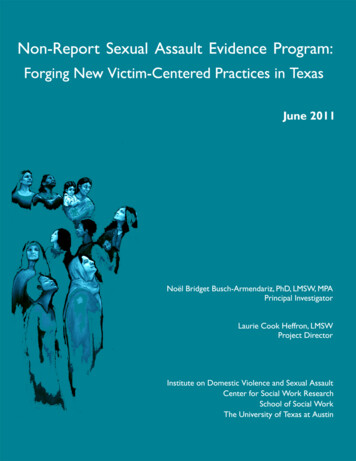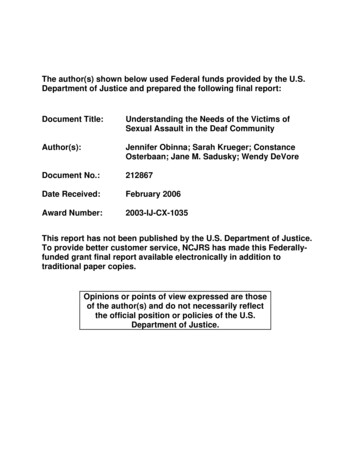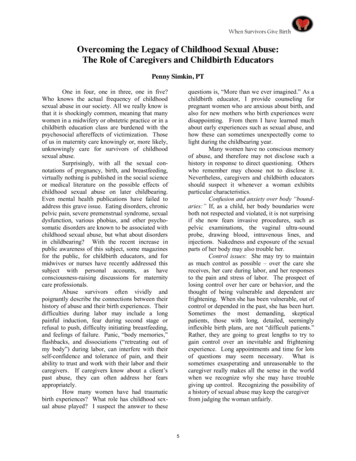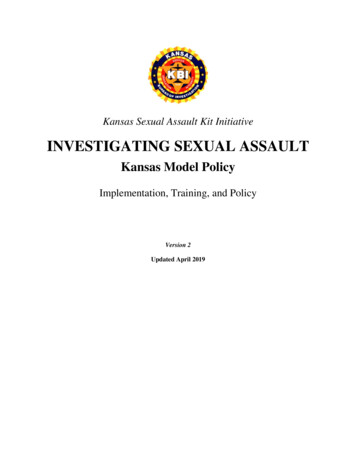
Transcription
Kansas Sexual Assault Kit InitiativeINVESTIGATING SEXUAL ASSAULTKansas Model PolicyImplementation, Training, and PolicyVersion 2Updated April 2019
The Kansas Sexual Assault Kit InitiativeINVESTIGATING SEXUAL ASSAULTKansas Model PolicyPolicy, Implementation and Training GuideOriginal version published June 2018Version 2 Updated April 2019This policy and related documents were developed as a project of the Kansas Sexual Assault KitInitiative.For an editable version of this model policy, please contact:Megan RobertsSAKI Site Coordinatormegan.roberts@kbi.state.ks.usThis project was supported by Grant No. 2015-AK-BX-K001 awarded by the Bureau of JusticeAssistance. The Bureau of Justice Assistance is a component of the Department of Justice’s Office ofJustice Programs, which also includes the Bureau of Justice Statistics, the National institute of Justice, theOffice of Juvenile Justice and Delinquency Prevention, the Office for Victims of Crime, and the SMARTOffice. Points of view or opinions in this document are those of the author and do not necessarilyrepresent the official position or policies of the U.S. Department of Justice.1June 14, 2018
AcknowledgementsThe development of this Kansas Model Policy for Investigating Sexual Assault: Implementation, Trainingand Policy was through the collaboration of the Kansas Sexual Assault Kit Initiative MultidisciplinaryWorking Group, composed of twenty-two experienced professionals – some agency policy makers, otherspractitioners – from across the state. Together, they represent disciplines of law enforcement, prosecution,community and system-based victim advocacy, forensic nursing, and forensic science laboratory.Contents for all of the provided documents were developed partly on the basis of material from thefollowing sources:International Association of Chiefs of Police. Investigating Sexual Assault: Model Policy, Concept &Issues Paper and Need to Know , 2017.Ottawa, Kansas Police Department. Investigating Sex Crimes, Criminal Investigation Policy, 2016.Michigan Domestic and Sexual Violence Prevention and Treatment Board. Michigan Model Policy: TheLaw Enforcement Response to Sexual Assault Adults and Young Adults, 2015.Chief (Ret.) Tom Tremblay, Consultant and Trainer. Trauma-Informed Sexual Assault InvestigationsTraining, 2016.North Dakota Department of Health, Division Injury Prevention and Control Division. North DakotaModel Sexual Assault Policy, 2011.Commonwealth of Massachusetts Executive Office of Public Safety and Security. Adult Sexual AssaultLaw Enforcement Guidelines, 2009.State of New Hampshire Governor’s Commission on Domestic and Sexual Violence. A Model Protocolfor Response to Adult Sexual Assault Cases, 2012.2June 14, 2018
Table of ContentsImplementation Guide . 5Training Guide. 7Purpose. 7Model Policy Development . 7Recommendations . 7Training Considerations . 7I.Background – Dispelling the Myths around Sexual Assault. 8II.Law Enforcement Interactions with the Victim . 9III.Special Considerations . 11IV.Victim Advocates . 12V.Drug and/or Alcohol Facilitated Sexual Assaults . 13VI.Sexual Assault Medical Forensic Examinations . 14VII.Contacting and Interviewing Suspects . 15VIII.Protecting Victim Rights . 15IX.Report Writing . 15XII.Self Care. 16Training Materials. 17State-Level Contact Information . 17Training Resources . 18Investigating Sexual Assault: Kansas Model Policy . 20I.Purpose. 20II.Policy . 20III.Definitions. 21IV.Procedure . 22A.Dispatch or Call-Taker Response . 22B.Initial Officer Response . 22C.Special Considerations . 24D.Role of Supervisor . 25E.Evidence Collection . 26F.Sexual Assault Medical Forensic Examinations . 27G.Formal/Follow-up Victim Interviews . 303June 14, 2018
H.Contacting and Interviewing Suspects . 32I.Forensic Examination for the Collection of Evidence from the Suspect . 35J.Protecting Victim Rights . 35K.Report Writing . 36N.Training . 37Appendix . 38Appendix A: Understanding Advocacy Roles . 38Appendix B: Translation Services Resource List . 39Appendix C: Demand for Information and/or Documentation for Law Enforcement InvestigativePurposes . 40Literature References . 414June 14, 2018
Imple mentatio n GuideKansas Sexual Assault Kit InitiativeIMPLEMENTATION GUIDEInvestigating Sexual Assault: Kansas Model PolicyGUIDING PHILOSOPHYLaw enforcement is responsible for identifying the person(s) responsible for criminal acts andbringing them to justice through complete, impartial and constitutional investigation practices. Theyare also responsible for conducting the investigative process in a manner to ensure all steps are takento remove suspicion from those not responsible for the criminal act.HOW WE GOT HEREThe provided model policy and training guide for sexual assault investigations were developed inresponse to findings from the Kansas Sexual Assault Kit Initiative (SAKI) publication of theUnderlying Factors Contributing to the Accumulation of Sexual Assault Kits in the State of Kansas.In particular, these documents are designed to create consistency across the state for law enforcementresponse to sexual assault cases, from dispatch through investigation and referral to prosecution.The development of this policy and training guide was through an evaluation of National bestpractices and Kansas statutes by the Kansas SAKI Multidisciplinary Working Group, which wascreated by the Kansas Bureau of Investigation. The working group includes representatives fromdisciplines of law enforcement, prosecution, community and system-based victim advocacy, forensicnursing, and the forensic science laboratory.RECOMMENDATIONThe Kansas SAKI Multidisciplinary Working Group recommends every Kansas Law EnforcementAgency adopt a written policy for topics covered by the offered Kansas Model Policy forInvestigating Sexual Assault. To facilitate the implementation of the model policy, the working groupalso recommends providing training to all law enforcement personnel involved in call-taking, initialresponse and investigations of sexual assault cases. This training should include topics covered by theoffered Kansas Training Guide for Investigating Sexual Assault.IMPLEMENTATIONThe Kansas Model Policy for Investigating Sexual Assault is not intended to be a “plug-and-play”solution, but rather should serve as a guide to assist law enforcement in internal discussions anddiscussions with local prosecutors, victim advocacy, and others representing your jurisdiction infurtherance of a final agency policy. Your final policy, which may or may not result in modificationsto the provided model policy, should be a derivative of those discussions.If your agency already has a written policy for sexual assault investigations, we encourage you to usethe provided documents to review your existing policy and perhaps find opportunities forimprovement or additions.5June 14, 2018
If you do not have a written policy for investigating sexual assaults, we encourage you to use theprovided documents to implement one for your agency. You should closely examine all aspects of themodel policy to identify:1. Any recent best practices research on the topic of sexual assault that is useful in clarifying thepurpose of the policy content.2. Critical points of the procedure that should remain intact.3. Areas already covered by other agency written policy that can be referenced instead ofduplicative direction provided in the model policy.4. Points that should be discussed with appropriate local leadership (prosecution, agency legalrepresentatives, victim advocacy, etc.) to determine if modifications to the model policy shouldbe made based on local needs, resources, judicial preferences, prosecutorial preferences, andother community based issues.Your agency’s resulting written policy for investigating sexual assaults, primarily aimed at providingguidance to law enforcement employees, should remain constructed in a manner to facilitate clarityfor those intended users. Successful policy implementation will also include training for employeeswho will carry out the agency policy, which should include topics as described in the providedKansas Training Guide for Investigating Sexual Assault. We encourage you to develop a plan forsuch training in conjunction with implementation of the policy.6June 14, 2018
Training GuideKansas Sexual Assault Kit InitiativeTRAINING GUIDEInvestigating Sexual Assault: Kansas Model PolicyPurposeThis paper was developed to accompany the Kansas Model Policy for Investigating Sexual Assaultdeveloped by the Kansas Sexual Assault Kit Initiative (SAKI) Multidisciplinary Working Group. Thepaper provides essential background material and supporting documentation to provide a greaterunderstanding of the developmental philosophy and implementation required for the model policy. It alsoaddresses field investigative procedures and best practices for working with victims of sexual violence.This material is designed to assist law enforcement agencies in tailoring the model policy to therequirements and circumstances of their own communities and agencies.Model Policy DevelopmentThe Kansas Model Policy for Investigating Sexual Assault was developed in response to the findings fromthe Kansas SAKI Multidisciplinary Working Group’s effort to identify the underlying factors contributingto the accumulation of sexual assault kits in the state of Kansas (Whisman & Roberts, 2017). In particular,this model policy is designed to create consistency across the state for law enforcement response to sexualassault cases, from dispatch through investigation. The development of this policy was through thecollaboration of the Kansas SAKI Multidisciplinary Working Group, composed of twenty-twoexperienced professionals – some agency policy makers, others practitioners- from across the state.Together, they represent disciplines of law enforcement, prosecution, community and system-basedvictim advocacy, forensic nursing, and forensic science laboratory.1RecommendationsThe Kansas SAKI Multidisciplinary Working Group recommends every Kansas Law EnforcementAgency provide training specific to investigating sexual assault that incorporates topics covered by theoffered model policy. Our goal is for this training document to facilitate that process. This training guideis not intended to be a substitute for a trauma-informed sexual assault investigations training course, butshould instead be used to assist in the development and deployment of such training.Training ConsiderationsThe provided Kansas Model Policy for Investigating Sexual Assault is not intended to be a “plug-andplay” solution, but instead should serve as a guide to assist law enforcement in internal discussions anddiscussions with local prosecutors, victim advocacy, and others representing your jurisdiction infurtherance of a final agency policy. Your final policy, which may or may not result in modifications to1Represented organizations and agencies include Kansas Bureau of Investigation, Kansas Association of Chiefs ofPolice, Kansas Sheriffs’ Association, Kansas County and District Attorneys’ Association, Office of the KansasAttorney General, Kansas Coalition against Sexual and Domestic Violence, Kansas Chapter of the InternationalAssociation of Forensic Nurses, Sedgwick County Regional Forensic Science Center, and Johnson County Sheriff’sOffice Criminalistics Laboratory.7June 14, 2018
the provided model policy, should be included in the development and deployment of your agency’straining for investigating sexual assault.Background – Dispelling the Myths around Sexual AssaultI.Sexual assault is a complex crime that can make investigations sometimes challenging. Estimates of theprevalence of sexual assault in the United States vary due to differences in data collection, definitions andcalculations. However, whether the estimate is 1 in 6 women or 1 in 33 men (RAINN, 2018), any victim2of sexual violence is one too many and the criminal justice system must be prepared to respondaccordingly.One of the most common cultural myths surrounding sexual assault involves the perception of whatconstitutes “real” rape. Most people assume that “real” rape is committed in a sudden and violent mannerby someone unknown to the victim. Contrary to this stereotype of a stranger with a weapon using a greatdeal of physical force, research and law enforcement experience demonstrates that the followingrepresents some of the realistic dynamics of sexual assault crimes (International Association of Chiefs ofPolice, 2017): Most sexual assault victims are acquainted with the suspect in some way.Most sexual assaults are not reported to law enforcement authorities.Victims of sexual violence include both men and women.Victims rarely report to law enforcement first; usually they go first to a close friend or relative, ahealth care provider, or a victim advocate.Victims often struggle with a range of emotions3 following a sexual assault; this can lead todelays and reluctance in reporting.Law enforcement is more likely to be notified of sexual assaults that are committed by strangersthan by someone the victim knows.Sexual assault perpetrators rarely use weapons and might not use physical force, relying insteadon verbal threats, intimidation, and a victim’s vulnerability.Sexual violence can have long-term effects on victims, including post-traumatic stress disorder,thoughts of suicide, increased drug use, and problems with friends, family and coworkers.Few victims are physically injured to a point that emergency medical attention is needed.Alcohol and/or drugs are involved in a high percentage of sexual assaults.The prevalence of false reports of sexual assault is between 2%-10% (Lisak et al., 2010).It is important to remember that one of the most critical responsibilities of responding officers andinvestigators in a sexual assault case is to assure the victim that he or she will not be judged and that theirreport will be taken seriously. Law enforcement agencies are expected to maintain a professional, traumainformed approach to sex crimes. Additionally, these crimes are expected to be investigated in a manner2The term “victim” is used throughout this document as well as the Kansas Model Policy for Investigating SexualAssault since it is the term most commonly used by the criminal justice system. However, we recognize that somestakeholder communities may use the terms “survivor,” “patient,” or “client” to emphasize empowerment thatindividuals can experience throughout the recovery and healing process.3The neurobiological and psychological trauma experienced by a victim of sexual assault may impact memory,behavior, and emotions, similar to the impact of trauma experienced by law enforcement during and/or after anofficer-involved shooting. Demonstrating patience and understanding while building trust with a victim will assist inovercoming these traumatic barriers.8June 14, 2018
that restores the victim’s dignity and sense of control while addressing the victim’s concerns anddecreasing their anxiety.Virtually all sexual assault victims want validation that the crime occurred, and this can be a more criticalcomponent to a successful response and investigation than a criminal prosecution or conviction. This canbe accomplished with a statement as simple as “I am sorry this happened to you.”Regardless of the investigative results, responding officers and investigators have the power to help avictim begin to heal from sexual assault.II.Law Enforcement Interactions with the VictimThe first impression of your agency, from the initial phone call through investigations, can make or breaka victim’s decision to report a sexual assault or continue their participation throughout the process.Dispatchers or call-takers, initial responding officers and investigators all play a significant role in avictim’s ability to cope with the emotional and psychological after-effects of a sexual assault. Therefore,it is especially important that these cases be handled with a trauma-informed approach that is objectiveand without bias; emphasizing physical, psychological, and emotional safety for victims; and treatingvictims with respect, dignity and sensitivity. Employing a consistent message of compassion, support, andconsideration for the victim has shown to not only improve the willingness of victim engagement in thecriminal justice process (Busch-Armendariz et al., 2015), but can also greatly impact the healing processof victims (Campbell & Raja, 1999).A. Dispatch or Call-TakersRegardless of when the crime occurred, sexual assaults should always be a priority call. A victimreaching out for assistance may be in crisis due to the trauma experienced by a sexual assault.This trauma can result in behaviors ranging from, but not limited to, hysteria, crying, rage,laughter, calmness, and/or unresponsiveness (Campbell & Raja, 1999). There is no one typicalreaction to trauma and these behaviors are likely to change over time. Therefore, it is critical torefrain from negative personal judgements and to continuously treat the victim with respect,sensitivity, and consideration.B. Initial Responding OfficerResponding officers and investigators must make every effort to keep an open mind by remainingobjective and refrain from bias or judgement regarding the information obtained from the victim.Remember that your tone when speaking to victims carries weight and it is important to remaincalm and understanding during all interactions with a victim.Officers and investigators should recognize that a victim may or may not have prior interactionswith law enforcement that can influence their feelings of safety and well-being. In accordancewith a trauma-informed approach, all personnel responding to a sexual assault should emphasizephysical, psychological, and emotional safety for victims. Once the scene is secure, officers andinvestigators can begin to build emotional and psychological safety by communicating empathyand support. This can be accomplished by telling the victim: I am sorry for what happened to you I am sorry we are meeting under these circumstances 9June 14, 2018
I commend you for reporting to the police Your health, safety, and wellness are a priority for me Responding officers should limit the initial interview of the victim to collecting only thenecessary information about the assault for the immediate needs of the investigation and safety ofthe victim.Responding officers should also recognize that because the victim experienced a traumatic event,he or she may not be able or willing to immediately assist with the investigation. Victims shouldbe reassured and empowered to report at their own pace, and be reminded that their memory ofthe incident may become clearer over time. Law enforcement must be willing to allow victims tore-engage with the investigation at any time, even if the victim is initially unable or unwilling toparticipate. While it is common for victims to delay reporting of a sexual assault, officers shouldbe aware of the victim’s emotional and physical state and should tailor questions appropriately.C. Formal/Follow-up Victim InterviewSexual assault is a traumatic event that can impact victims’ memory, behavior and emotions(Campbell et al., 2009). It is important for investigators to be aware of these impacts, recognizethe various ways in which trauma can present in victims of sexual assault, and incorporatetrauma-informed practices when interviewing victims to build trust and facilitate cooperation.The formal or follow-up victim interview is recommended to occur at least one to two sleepcycles after the incident to allow the victim to rest and recover from some of the traumaexperienced by the assault. Delaying the formal interview is also critical if the victim is stillintoxicated or under the influence of drugs or alcohol at the time of reporting as their ability toprovide information can be impaired. However, some victims may prefer to conduct the in-depthinterview immediately and law enforcement should be prepared to accommodate the interview tomeet the victim’s abilities and requests.Before beginning the formal interview, investigators must build a sense of emotional andpsychological safety for the victim. To begin this process, investigators should communicateempathy and support of the victim by reiterating: I am sorry for what happened to you I commend you for reporting to the police I know this is difficult Your health, safety, and wellness are a priority for me When conducting the formal interview, it is important to allow the victim to provide anuninterrupted report of the incident. The investigator should encourage the victim to beginwherever they are able in their memory of the event and should display patience and activelistening throughout the victim’s narrative. Questions for clarification and understanding shouldbe held until the victim has completed their full narrative. Investigators must also be receptiveand accommodating to stopping or taking breaks as needed by the victim.Regardless of the facts present in a particular assault, the phrasing of questions posed to thevictim can imply blame. For example, for purposes of evidence collection it may be necessary toknow what the victim was wearing during the time of assault or whether alcohol was present.10June 14, 2018
However, if the necessity of the question is not explained to the victim, he or she may perceivethis question to imply that the assault occurred because of their clothing choice or consumption ofalcohol.Questions posed to the victim should always avoid language that implies blame, includingquestions that involve the phrases “why did you ?” or “why didn’t you ?” Additionally, thetone utilized when asking the question is important to communicate safety and compassion ratherthan doubt and scrutiny. Using a trauma-informed approach to collect the necessary informationfrom a victim should focus on clarifying and understanding the experience of the victim. This canbe accomplished by using the following phrases: What are you able to tell me about Can you tell me more about Can you help me understand your thoughts when How did that make you feel when Additionally, victims should be reassured that the focus of the investigation is the reported assaultand not to prosecute the victim for use of drugs or underage drinking. The presence or use of suchsubstances shall never be used to discredit or discourage the victim from reporting the assault,even if the victim previously lied or did not disclose this information during the initial interview.It is vital to reassure victims throughout the reporting process and remain patient.Because of the impact trauma can have on the way memory is formed and recalled, victims mayhave difficulty detailing the sequence of events or may not recognize the significance of certainaspects of their report. A trauma-informed approach relies on exploring sensory details to assistwith memory recall and identify corroborative evidence. This includes asking the victim whatthey are able to tell you about what they smelled, tasted, saw, felt, or heard before, during andafter the assault. These sensory details may trigger additional memories for the victim or provideadditional investigative leads that can further assist with determining the facts of the case.Remember that the trauma experienced by a victim of sexual assault may never fully go away andthat the process of reporting and detailing their experience can be triggering. Investigators shouldcontinue to reassure victims by exhibiting patience and compassion while acknowledging thedifficulty in discussing the event in such detail. At no point should the victim interview turn intoan interrogation.The conclusion of the interview can be a vulnerable and isolating time for victims. They have justrelived a traumatic event in detail and are likely experiencing a variety of emotions and concerns.It is vital that investigators work with victim advocates and local support services to ensure thatthe victim does not feel abandoned at the conclusion of the interview. Every attempt should bemade to arrange a warm handoff or make direct contact with a victim advocate.Investigators should encourage the victim to contact them with any additional information thatthey may recall over time and be receptive to that information when it is available.III.Special ConsiderationsWhile every sexual assault case will pose unique challenges and require special considerations, there aresome specific situations that require law enforcement to identify appropriate resources and partnerships11June 14, 2018
prior to receiving a call. These situations may include, but are not limited to, child victims, special needsvictims, cases involving domestic violence or offenders residing with the victim, assaults that occur on amilitary or college campus, and cases in which a law enforcement employee is a suspect. The protocol forhandling these specialized cases may be different than that outlined by the model policy, which wasdesigned to serve as guidelines for investigating sexual assault of competent adults. Considerationsshould be given to utilize individuals with specialized training and experience whenever reasonablypossible for victims in these situations. Agencies that do not have the internal capabilities to effectivelyrespond to these specialized population groups are urged to identify and contact local, regional, state, ornational organizations that can provide a working relationship with the nearest agency. Thi
Agency provide training specific to investigating sexual assault that incorporates topics covered by the offered model policy. Our goal is for this training document to facilitate that process. This training guide is not intended to be a substitute for a trauma-informed sexual assault investigations training course, but
